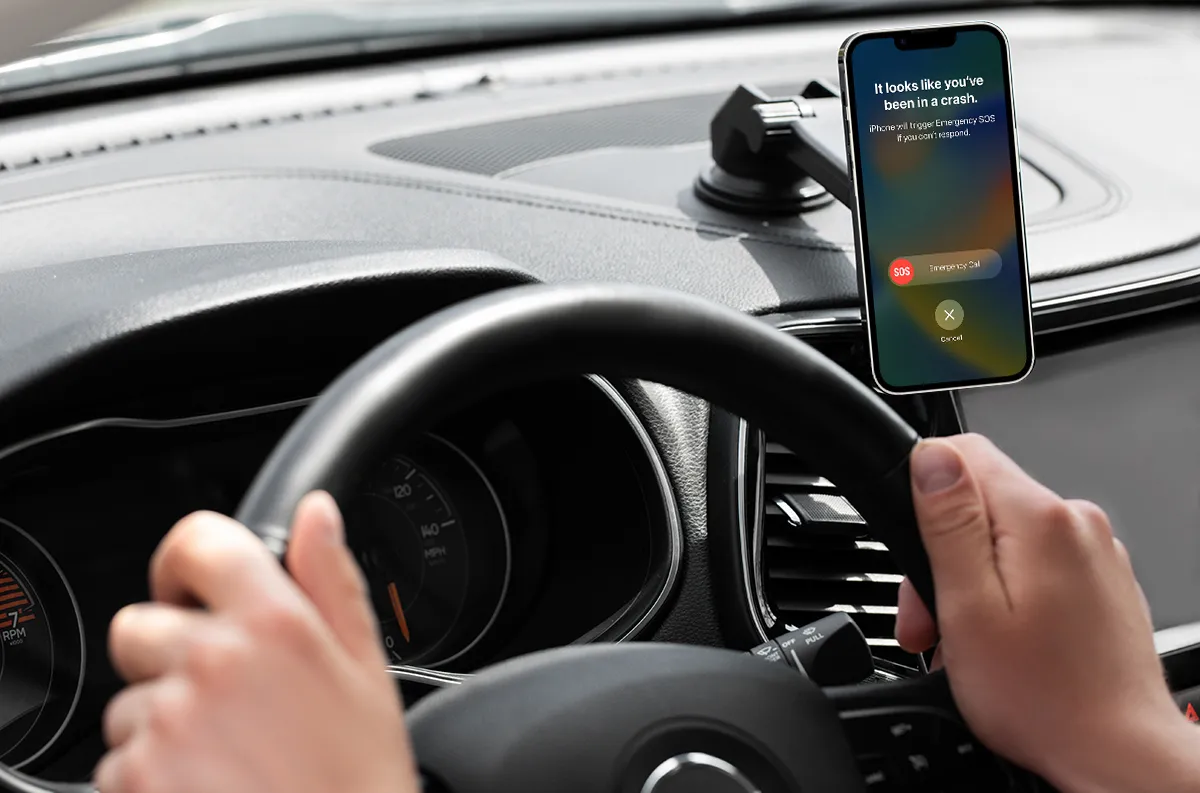Latest iPhone 14 announcement regarding crash detection creates opportunities, but requires insurers take a cautious approach
The recent release of the latest generation smartphone from Apple (iPhone14) and other updates to select Android phones (e.g., the Google Pixel) raises telematics awareness by shining a spotlight on the value of vehicle crash detection. This can only be good news for auto insurers who have the opportunity to build on the increased consumer education, awareness and enthusiasm for this release. By strengthening their offerings while pointing out the shortcomings of basic smartphone crash detection, insurers can amplify services to support the capabilities of the new smartphones and venture farther into automated, data-oriented claims handling and other areas where telematics provides compelling process improvements and substantial savings.
While moving in the right direction, there are some key considerations and watch-outs insurers must bear in mind before relying on built-in smartphone crash detection capabilities:
- Supports only high impact collisions – Low-impact crashes are not well detected because of the lack of sensitivity – with low-impact representing the majority of all collisions. Unfortunately, this keeps the door open for fraudulent activity given the lack of reliably detecting all forms of collision. Effective claims processing and the right device sensitivity make it possible to identify both high- and low-impact collisions successfully. Lack of accuracy also makes it difficult to perform accident reconstruction, determine accident liability, and construct other details of the accident. Solidly mounted Bluetooth devices (like the IMS Wedge) with greater sensitivity can be used in conjunction with the smartphone to compliment the smartphone sensors and collect a richer set of data.
- Lack of crash detection in market share of existing, in-use smartphones – While new customers can benefit from the crash-detection capability, the overwhelming majority of smartphone uses continue to use hardware which is not crash detection capable. Insurers should be ready if the demand arises to offer similar services to those consumers who own earlier models and ensure that any program be operable with both new and legacy devices. In most cases, this will result in the requirement to provide complimentary add-on hardware (i.e., add-on Bluetooth devices like the IMS Wedge) to ensure a mass consumer-facing claims telematics program can be realized.
- Technology unproven and not fully tested in the open market – Telematics in various forms has been around for many years. However, the new smartphones with built-in crash detection telematics technology haven’t been around long enough to determine the accuracy of data, the validity of crash incident recordings, and whether insurance policies can be reliably based on their performance. Smartphones have been used successfully with telematics programs reliably, but insurers need more metrics to determine whether the new crash detection features are dependable. Also noteworthy is that services, such as emergency notification, need to be field tested through consumer use to determine if they accurately summon services when needed. Too many false positive emergencies and consumers will likely be shutting off the crash-protection feature.
- Limited emergency and crash notifications – The iPhone14, and newer Android devices, are equipped with the capability of summoning emergency services automatically in a certain time period if there is a serious accident that renders the driver unable to make a call. In cases where perhaps the circumstances are not so dire, this service capability could be extended by the insurer to automatically trigger emergency services and first notice-of-loss (FNOL), as well as recovery and repair services and to activate other parts of the claim’s process – providing extremely deep benefits to both consumers and insurers by increasing speed of assistance while lso reducing time and cost throughout the entire claims shelf life. Other innovations could be exploited by insurer. For example, the iPhone14 smartphone can use satellite frequencies for Emergency SOS contacts (so far, in the US and Canada only). This feature could be integrated into the insurer’s portfolio of services, providing fast accident response in areas where Wi-Fi and cellular services are unavailable. This increases the safety aspects of the feature considerably.
- General lack of data precision – Without a set of sensors provided by another fixed mounted or add-on Bluetooth hardware, smartphones paint an incomplete and potentially inaccurate picture of a crash. The problem is that the sensors included with smartphones have a limited response to G-forces and can be overloaded to diminish the value of data to insurers. Furthermore, the smartphone often moves at the time of collision providing an unclear picture of what happened at time of impact. An automated claims handling process, helpful to insurers in reducing the cost of liability claims, relies on a wealth of data for crashes of any magnitude that can then be analyzed to gain many details about a crash that requires supplementing the phone’s capabilities with additional add-on tech to be of most value to the insurer.
Increased consumer awareness of these new, but basic, smartphone crash-detection capabilities can only benefit insurers, leading to an interest in more comprehensive claims telematics services and overall claims handling improvements that will benefit both the insurer and consumer. To insurers, it is an ideal opportunity to introduce innovative new telematics-based services, extending from simple First Notice of Loss (FNOL) to sophisticated, more efficient claims handling services that decrease overall claims handling costs and resolve claims more quickly for consumers.
While built-in crash-detection functionality is a useful entry point to crash and claims handling telematics services, the feature can be expanded to be much more useful to insurers by adding complimentary software processes and low-cost add-on hardware technology. Because of the infancy of the current crash detection technology, the lack of standard across smartphone manufacturers and operating systems and the issue of legacy, non-crash detection compatible smartphones still in use, waiting for smartphone manufactures to solve the core considerations identified in this article is an unrealistic goal. A knowledgeable telematics service provider can provide guidance in making the most of the new technology while ensuring mass market usage of your claims telematics program and objectives.
About IMS
IMS (Insurance & Mobility Solutions) is a vehicle and driving data business, delivering enterprise solutions to global insurers, mobility operators and governments. The IMS DriveSync platform provides the capability for customers to improve their approach to pricing, customer engagement, risk management and claims handling by leveraging telematics data from any source – smartphone apps, aftermarket hardware and OEM embedded units. The company, with offices across the UK, Europe and North America, has analyzed over 15 billion driving miles and its algorithms are fed by trillions of data points each day. For more info visit ims.tech
IMS Connected Claims
IMS Connected Claims is a low-cost suite of telemetry-based services that transforms collected telematics data into appropriate analysis that positively impacts the policyholder experience and an organization’s claims costs. The solution includes hardware, ongoing training and implementation consulting, along with expert support services.
Find out more: https://ims.tech/claims/
About IMS Wedge
The IMS Wedge is IMS’s patented fixed-mounted Bluetooth smartphone program add-on that can be paired with most smartphone device and used to enhance the data and accuracy of an insurer’s mobile telematics program. The IMS Wedge is of a small size that enables discrete installation in any car by attaching to the windscreen with a 3M VHB pad. It is uniquely shaped to correctly orientate the accelerator without requiring power hungry orientation algorithms. The IMS Wedge has a low-profile two-part enclosure suitable for lower cost 25mm thick letter shipping and is suitable for any vehicle including electric and hybrids.
Learn More: Download Additional Resources:
Datasheet: IMS Connected Claims Solution
Datasheet: IMS Wedge Bluetooth Low Energy Beacon
White Paper: Improving Claims ROI and Claims Operations with Telematics Data



